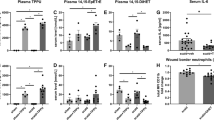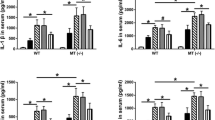Abstract
The prevention and treatment strategies for traumatic infection often focus on the use of antibiotics, while eschew the combined treatment of the bacteria, their toxins, and inflammatory mediators. This might be a main reason the prognosis of wound victims has not improved. Although our previous work found that the combination of indomethacin (IND) and ciprofloxacin (CIP) could promote skin wound repair and enhance the immune function, the efficacy and safety of this strategy for severe traumatic infection-mediated complications remain unknown. Additionally, there is no study on the relevant target cells and molecular mechanisms. In this study, C57BL/6 adult male mice were modeled for severe traumatic infection, and the optimal doses of IND and CIP alone were determined. After that, the efficacy and safety of IND plus CIP in traumatic infection mice were explored. Then the differentially expressed genes of activated macrophages in this process were analysed and verified by transcriptomic methods and conventional experimental techniques. The role of a candidate signalling pathway (PI3K/Akt) in regulating macrophage function and drug combination therapy was evaluated. The results showed that IND plus CIP increased the survival rate, reduced the degree of inflammatory response, and enhanced the bacteriostatic effect in mice under traumatic infection. This combined therapy did not cause significant damage to the functions of important organs (liver, kidney, heart). In addition, IND combined with CIP induced macrophages to significantly change their expression levels of several cytokines, including interleukin (IL) -1β, IL-6, IL-10, IL-22, IL-23A, IL-17A, IL-17F, cluster of differentiation (CD) 11b and other genes/encode proteins. Further study showed that intervention with the PI3K inhibitor LY294002 modulated the secretion function of the above-mentioned macrophages and Akt activation (phosphorylation at serine 473). IND plus CIP can regulate macrophage function through the PI3K/Akt signalling pathway and improve the prognosis of severe traumatic infected mice. This may be a new therapeutic strategy for the prevention and treatment of severe traumatic infection.











Similar content being viewed by others
Data Availability
Data will be made available on request.
Abbreviations
- AKT:
-
Protein kinase B
- Alb:
-
Albumin
- ALP:
-
Alkaline phosphatase
- ALT:
-
Alanine aminotransferase
- ANOVA:
-
Analysis of variance
- AST:
-
Aspartate aminotransferase
- CD:
-
Cluster of differentiation
- cfu:
-
Colony forming unit
- CIP:
-
Ciprofloxacin
- CK:
-
Creatine kinase
- CK-MB:
-
Creatine kinase isoenzyme-MB
- Crea:
-
Creatinine
- DBil:
-
Direct bilirubin
- ELISA:
-
Enzyme-linked immunosorbent assay
- Glb:
-
Globulin
- GGT:
-
Gamma-glutamyl transferase
- g:
-
Gram
- IBil:
-
Indirect bilirubin
- IL-1β:
-
Interleukin-1β
- IL-6:
-
Interleukin-6
- IL-10:
-
Interleukin-10
- IL-17A:
-
Interleukin-17A
- IL-17F:
-
Interleukin-17F
- IL-22:
-
Interleukin-22
- IL-23A:
-
Interleukin-23A
- IND:
-
Indomethacin
- LDH:
-
Lactic dehydrogenase
- LPS:
-
Lipopolysaccharide
- μL:
-
Microliter
- mL:
-
Milliliter
- min:
-
Minutes
- NSAID(s):
-
Nonsteroidal anti-inflammatory drug
- PA:
-
Prealbumin
- PI3K:
-
Phosphatidylinositol 3 kinase
- qRT-PCR:
-
Quantitative real-time poly-enzyme chain reaction
- SPF:
-
Specific pathogen free
- TBil:
-
Total bilirubin
- TNF-α:
-
Tumor necrosis factor-α
- TP:
-
Total protein
References
Liu, K., J. Yu, Y.J. Liu, L.T. Zhang, S.Y. Li, and J. Yan. 2020. Research progress in application of non-steroidal anti-inflammatory drugs in treatment of complications secondary to severe combat wounds and trauma. Chinese Journal of Traumatology 36: 1140–1145.
Walsh, S.A., B.W. Hoyt, C.J. Rowe, D. Dey, and T.A. Davis. 2021. Alarming cargo: The role of exosomes in trauma-induced inflammation. Biomolecules 11: 522.
Gupta, D.L., A. Sharma, K.D. Soni, S.N. Kazim, S. Bhoi, and D.N. Rao. 2021. Changes in the behaviour of monocyte subsets in acute post-traumatic sepsis patients. Molecular Immunology 136: 65–72.
Lee, C.C., K.A. Marill, W.A. Carter, and R.S. Crupi. 2021. A current concept of trauma-induced multiorgan failure. Annals of Emergency Medicine 38: 170–176.
Chen, L., B. Gao, Y. Zhang, H. Lu, X. Li, L. Pan, et al. 2019. PAR2 promotes M1 macrophage polarization and inflammation via FOXO1 pathway. Journal of Cellular Biochemistry 120: 9799–9809.
Locati, M., G. Curtale, and A. Mantovani. 2021. Diversity, mechanisms, and significance of macrophage plasticity. Annual Review of Pathology: Mechanisms of Disease 15: 123–147.
Na, Y.R., M. Stakenborg, S.H. Seok, and G. Matteoli. 2019. Macrophages in intestinal inflammation and resolution: A potential therapeutic target in IBD. Nature Reviews. Gastroenterology & Hepatology 16: 531–543.
Watanabe, S., M. Alexander, A.V. Misharin, and G.R.S. Budinger. 2019. The role of macrophages in the resolution of inflammation. The Journal of Clinical Investigation 129: 2619–2628.
Hain, E.G., M. Sparenberg, J. Rasińska, C. Klein, L. Akyüz, and B. Steiner. 2018. Indomethacin promotes survival of new neurons in the adult murine hippocampus accompanied by anti-inflammatory effects following MPTP-induced dopamine depletion. Journal of Neuroinflammation 15: 162.
Kao, R.L., W. Huang, C.M. Martin, and T. Rui. 2018. The effect of aerosolized indomethacin on lung inflammation and injury in a rat model of blunt chest trauma. Canadian Journal of Surgery 61: S208–S218.
Tomida, S., K. Aizawa, N. Nishida, H. Aoki, Y. Imai, R. Nagai, et al. 2019. Indomethacin reduces rates of aortic dissection and rupture of the abdominal aorta by inhibiting monocyte/macrophage accumulation in a murine model. Science and Reports 9: 10751.
Rehman, A., W.M. Patrick, and I.L. Lamont. 2019. Mechanisms of ciprofloxacin resistance in Pseudomonas aeruginosa: New approaches to an old problem. Journal of Medical Microbiology 68: 1–10.
Duque, A., C. Vinader-Caerols, and S. Monleón. 2017. Indomethacin counteracts the effects of chronic social defeat stress on emotional but not recognition memory in mice. PLoS ONE 12: e0173182.
Monleón, S., A. Duque, and C. Vinader-Caerols. 2020. Emotional memory impairment produced by binge drinking in mice is counteracted by the anti-inflammatory indomethacin. Behavioural Brain Research 381: 112457.
Enos, R.T., J.M. Davis, J.L. McClellan, J.L. Lake, M.D. Carmichael, and E.A. Murphy. 2013. Negative interaction between indomethacin and exercise in mice. International Journal of Sports Medicine 34: 191–195.
Popper, M., S. Gancarčíková, M. Maďar, D. Mudroňová, G. Hrčková, and R. Nemcová. 2016. Amoxicillin-clavulanic acid and ciprofloxacin-treated SPF mice as gnotobiotic model. Applied Microbiology and Biotechnology 100: 9671–9682.
Jaber, D.F., M.N. Jallad, and A.M. Abdelnoor. 2017. The effect of ciprofloxacin on the growth of B16F10 melanoma cells. Journal of Cancer Research and Therapeutics 13: 956–960.
Jang, H.C., S.M. Choi, H.K. Kim, S.E. Kim, S.J. Kang, K.H. Park, et al. 2014. In vivo efficacy of the combination of ciprofloxacin and cefotaxime against Vibrio vulnificus sepsis. PLoS One 9: e101118.
Komori, A., H. Iriyama, T. Kainoh, M. Aoki, T. Naito, and T. Abe. 2021. The impact of infection complications after trauma differs according to trauma severity. Science and Reports 11: 13803.
Wang, Z., and H. Liang. 2015. New strategies for prevention and treatment of combat-related infection and sepsis. Chinese Journal of Hygiene Rescue (Electronic Edition) 1: 13–15.
Sauaia, A., F.A. Moore, and E.E. Moore. 2017. Postinjury inflammation and organ dysfunction. Critical Care Clinics 33: 167–191.
Singer, M., C.S. Deutschman, C.W. Seymour, H.M. Shankar, D. Annane, M. Bauer, et al. 2016. The third international consensus definitions for sepsis and septic shock (sepsis-3). Journal of the American Medical Association 315: 801–810.
Varela, M.L., M. Mogildea, I. Moreno, and A. Lopes. 2018. Acute inflammation and metabolism. Inflammation 41: 1115–1127.
Grösch, S., E. Niederberger, and G. Geisslinger. 2017. Investigational drugs targeting the prostaglandin E2 signaling pathway for the treatment of inflammatory pain. Expert Opinion on Investigational Drugs 26: 51–61.
Khan, Y.S., H. Gutiérrez-de-Terán, and J. Åqvist. 2018. Molecular mechanisms in the selectivity of nonsteroidal anti-inflammatory drugs. Biochemistry 57: 1236–1248.
Schjerning, A.M., P. McGettigan, and G. Gislason. 2020. Cardiovascular effects and safety of (non-aspirin) NSAIDs. Nature Reviews. Cardiology 17: 574–584.
Smith, C.E., S. Soti, T.A. Jones, A. Nakagawa, D. Xue, and H. Yin. 2017. Non-steroidal anti-inflammatory drugs are caspase inhibitors. Cell Chemical Biology 24: 281–292.
Ahmed, E.F., R.M.A. El-Baky, A.B.F. Ahmed, N.G. Fawzy, N.A. Aziz, and G.F.M. Gad. 2016. Evaluation of antibacterial activity of some non-steroidal anti-inflammatory drugs against Escherichia coli causing urinary tract infection. African Journal of Microbiology Research 10: 1408–1416.
Worthington, R.J., and C. Melander. 2013. Combination approaches to combat multidrug - resistant bacteria. Trends in Biotechnology 31: 177–184.
Tahami, S.M., A. Aminian, and N. Azarpira. 2020. Experimental study on protective role of NSAID on articular cartilage destruction in septic arthritis. Archives of Bone and Joint Surgery 8: 89–93.
Kaur, B.P., and E. Secord. 2015. Innate Immunity. Pediatric Clinics of North America 66: 905–911.
Artis, D., and H. Spits. 2015. The biology of innate lymphoid cells. Nature 517: 293–301.
Davies, L.C., and P.R. Taylor. 2015. Tissue-resident macrophages: Then and now. Immunology 144: 541–548.
Yunna, C., H. Mengru, W. Lei, and C. Weidong. 2020. Macrophage M1/M2 polarization. European Journal of Pharmacology 877: 173090.
Dey, P., D. Parai, M. Banerjee, S.T. Hossain, and S.K. Mukherjee. 2020. Naringin sensitizes the antibiofilm effect of ciprofloxacin and tetracycline against Pseudomonas aeruginosa biofilm. International Journal of Medical Microbiology 310: 151410.
Fan, M., S. Chen, Y. Weng, X. Li, Y. Jiang, X. Wang, et al. 2020. Ciprofloxacin promotes polarization of CD86+CD206- macrophages to suppress liver cancer. Oncology Reports 44: 91–102.
Chae, B.S. 2002. Comparative study of the endotoxemia and endotoxin tolerance on the production of Th cytokines and macrophage interleukin-6: Differential regulation of indomethacin. Archives of Pharmacal Research 25: 910–916.
Navas, A., F. Jannus, B. Fernández, J. Cepeda, M.M. O’Donnell, L. Díaz-Ruiz, et al. 2020. Designing single-molecule magnets as drugs with dual anti-inflammatory and anti-diabetic effects. International Journal of Molecular Sciences 21: 3146.
Liu, K., J. Yu, Y. **a, L.T. Zhang, S.Y. Li, and J. Yan. 2022. The combination of ciprofloxacin and indomethacin suppresses the level of inflammatory cytokines secreted by macrophages in vitro. Chinese Journal of Traumatology 25: 379–388.
Arranz, A., C. Doxaki, E. Vergadi, Y.M. de la Torre, K. Vaporidi, E.D. Lagoudaki, et al. 2012. Akt1 and Akt2 protein kinases differentially contribute to macrophage polarization. Proceedings of the National Academy of Sciences 109: 9517–9522.
Lee, Y.G., J. Lee, S.E. Byeon, D.S. Yoo, M.H. Kim, S.Y. Lee, et al. 2011. Functional role of Akt in macrophage-mediated innate immunity. Frontiers in Bioscience 16: 517–530.
Vergadi, E., E. Ieronymaki, K. Lyroni, K. Vaporidi, and C. Tsatsanis. 2017. Akt signaling pathway in macrophage activation and M1/M2 polarization. The Journal of Immunology 198: 1006–1014.
Funding
The study was supported by Science and Technology Innovation Enhancement Project of Army Medical University (Third Military Medical University) (2019XYY22) and Major Project of National Science and Technology (2019ZX09301-167).
Author information
Authors and Affiliations
Contributions
K L mainly performed the experiments and drafted the manuscript. Y X and L Z participated in the study. W L and S D provided detection platform of clinical laboratory. S L guided the study. J Yu administrated the study and drew the schematic diagram. J Yan designed the study, rewrote the manuscript and supplied financial support. All authors read and approved the final manuscript.
Corresponding authors
Ethics declarations
Competing Interests
The authors declare no competing interests.
Conflict of Interests
The authors declare that no conflict of interest exists.
Ethics Approval and Consent to Participate
This study was approved by Laboratory Animal Welfare and Ethics Committee of Army Medical University (Third Military Medical University).
Additional information
Publisher's Note
Springer Nature remains neutral with regard to jurisdictional claims in published maps and institutional affiliations.
Supplementary Information
Below is the link to the electronic supplementary material.
Rights and permissions
Springer Nature or its licensor (e.g. a society or other partner) holds exclusive rights to this article under a publishing agreement with the author(s) or other rightsholder(s); author self-archiving of the accepted manuscript version of this article is solely governed by the terms of such publishing agreement and applicable law.
About this article
Cite this article
Liu, K., **a, Y., Zhang, L. et al. Indomethacin Combined with Ciprofloxacin Improves the Prognosis of Mice under Severe Traumatic Infection via the PI3K/Akt Pathway in Macrophages. Inflammation (2024). https://doi.org/10.1007/s10753-024-02008-3
Received:
Revised:
Accepted:
Published:
DOI: https://doi.org/10.1007/s10753-024-02008-3




